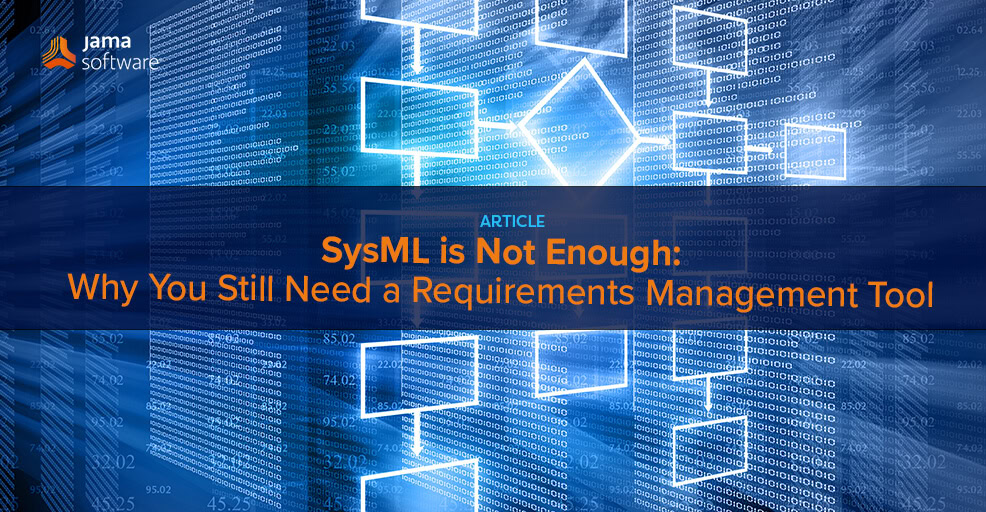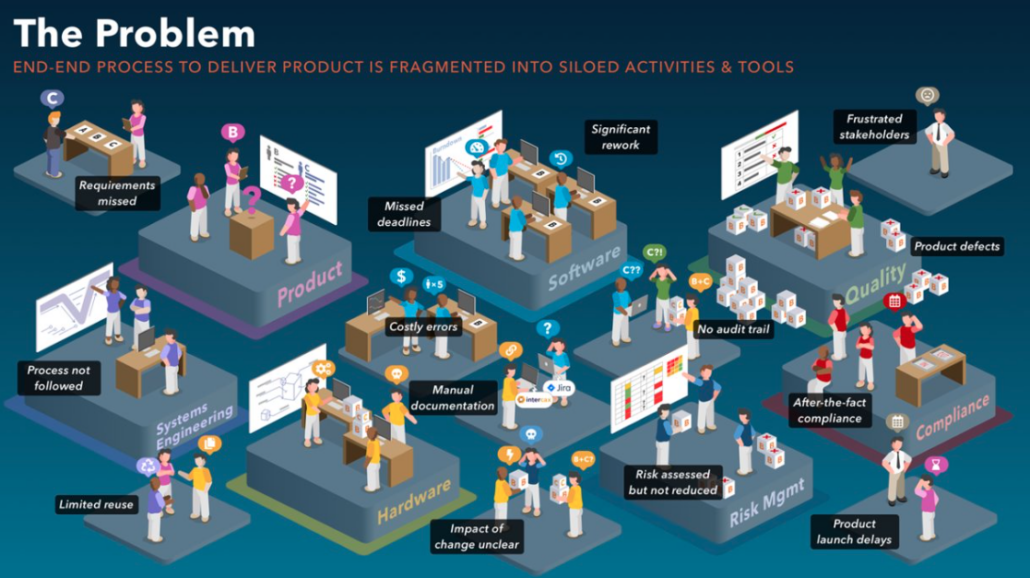SysML is Not Enough: Why You Still Need a Requirements Management Tool
All engineering process models (Agile, waterfall, spiral development, V-model, concurrent engineering, iterative…) describe managing requirements as the most critical key to success. Well-understood requirements provide a single connection point for communication across the engineering teams. Using a Systems Modeling Language (SysML) tool alone to manage requirements instantly creates a silo between engineering teams.
Requirements, tests, architectures, and risks are utilized by every stakeholder when developing a new product or building or modernizing a new system. Customers generate needs and requirements and care what the development status of those are and whether the development team is following the necessary process especially if it requires contract adherence or must meet regulatory laws or industry standards.
Software, hardware, and testing teams also access requirements to be able to analyze, develop, and test. Additionally, they are creating requirements at their given subsystem level too.
Systems Engineers work across all levels of requirements and coordinate the other engineering disciplines. NASA best describes it as, “Systems engineering is a holistic, integrative discipline, wherein the contributions of structural engineers, electrical engineers, mechanism designers, power engineers, human factors engineers, and many more disciplines are evaluated and balanced, one against another, to produce a coherent whole that is not dominated by the perspective of a single discipline.” – NASA
As you can imagine functionality such as configuration management of requirements, traceability between needs, requirements, tests, risks, and architecture are necessary. Systems engineers have been using various tools and even manual techniques for decades to do this.
RELATED: Buyer’s Guide: Selecting a Requirements Management and Traceability Solution
The Advertised Purpose of SysML
SysML is a graphical modeling language that is used within some systems modeling tools (such as Dassault’s Catia Nomagic) that enables systems engineers to perform “engineering” of the system. SysML “supports the specification, analysis, design, verification, and validation of a broad range of systems and systems-of-systems.” – Wikipedia
SysML is only a decade old; already a new, more complex version has recently been released; and SysML is yet to be widely adopted. It is widely thought to hold promise for the discipline of model-based systems engineering (MBSE). It is not the only language in use for MBSE though; LML and OPM are examples of modeling languages too, being used within other systems modeling tools.
However, a SysML model is difficult even for those trained in the language. Some indicate the learning curve is steep and the mechanics in the tools are difficult as cited in a recent article by Technology Strategy Partners. Additionally, the variety of tools that support SysML don’t consider themselves as a replacement for a true requirements management tool either. Capabilities from a dedicated requirements management tool such as Jama Connect have built-in collaboration, configuration management, baselines, managing traceability across multiple levels of objects, managing the verification and validation activities, controlling access and change to objects using role-based permissions, and showing real-time workflow states at the object level.
“What SysML lacks is its usage during key Systems Engineering (SE) phases like detail design or implementation phases wherein specific solutions like CAD, Software coding or network design for embedded systems are used,” said Kiran Jacob, Dassault Systems.
Also challenging is usage by software teams during later-stage design phases. Communication of the model (its requirements) becomes critical when needing to validate requirements with the customer, with product managers, and with other engineering disciplines outside of the SysML Scribe (tool jockey). The greater responsibility of the systems engineer as a cross-disciplined communicator requires the use of tools outside of the SysML tool to communicate. Effective communication of requirements is best represented in dedicated requirements management tools.
RELATED: Traceable Agile™ – Speed AND Quality Are Possible for Software Factories in Safety-critical Industries
Conclusion
In conclusion, while SysML and other modeling languages offer significant promise for the discipline of model-based systems engineering, they are not without their challenges. The complexity of SysML, along with its steep learning curve and the limitations of the tools supporting it, often hinders its effectiveness in later stages of design and implementation. As such, relying solely on SysML can create silos within engineering teams, impeding the critical communication and coordination necessary for successful systems engineering.
Effective requirements management remains the cornerstone of any engineering process, ensuring all stakeholders — from customers to software and hardware teams — are aligned and informed. Dedicated requirements management tools, such as Jama Connect, offer robust features like collaboration, configuration management, and traceability, which are essential for managing the multifaceted aspects of modern engineering projects. These tools facilitate clear communication of requirements, verification, and validation activities across all engineering disciplines, thereby supporting the holistic, integrative approach championed by systems engineering.
Ultimately, the synergy between specialized requirements management tools and SysML can provide a comprehensive solution, leveraging the strengths of both to enhance the efficiency and success of engineering projects. As the field continues to evolve, adopting a balanced approach that incorporates the best practices and tools from both domains will be key to navigating the complexities of modern systems engineering.
- [Webinar Recap] Streamline Your Program Management: Techniques to Manage Work Breakdown Structures (WBS) - October 23, 2025
- An Inside Look at the Airborne Fire Control Radar Market: The Sky’s AI - October 16, 2025
- Self-Hosted and Cloud: Flexible Deployment Options for Your Requirements Management with Jama Software - June 24, 2025


